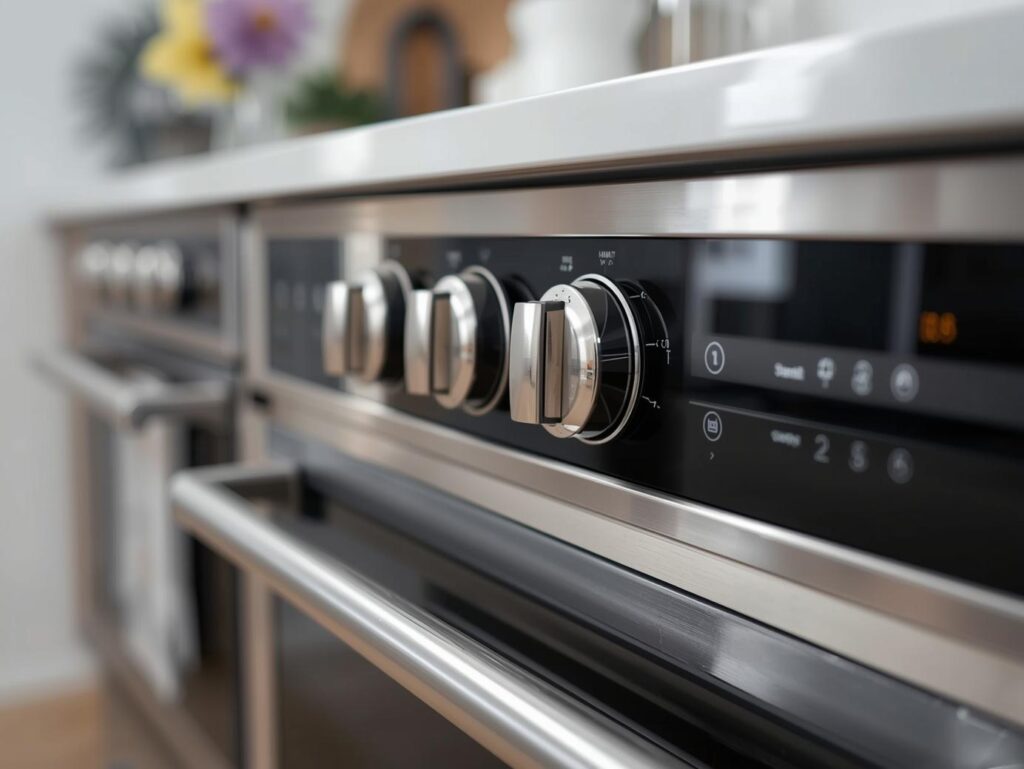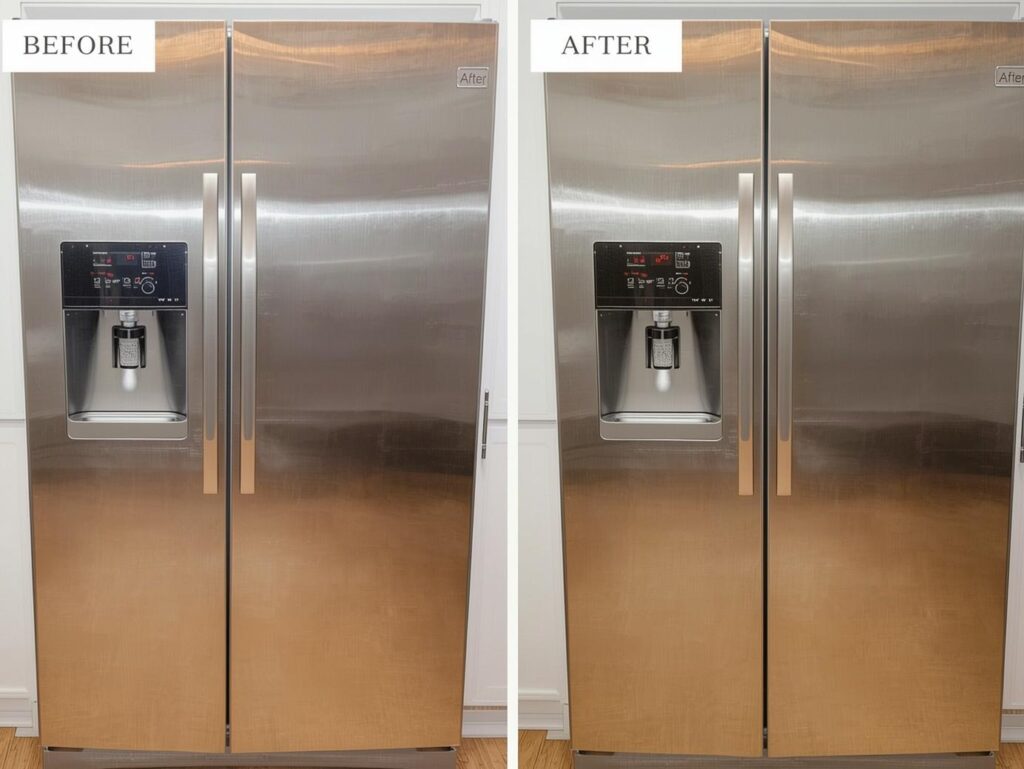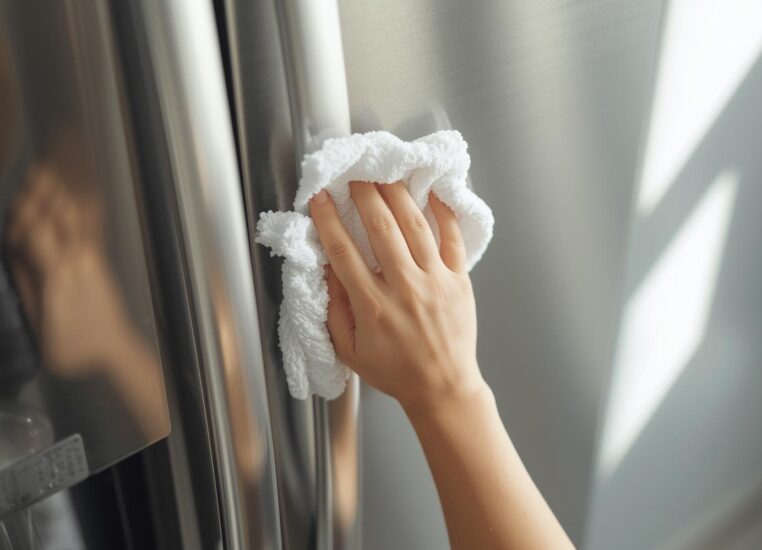Stainless steel appliances are the crown jewels of modern kitchens.
Their sleek, shiny surfaces make any space look fresh and contemporary.
But as anyone who owns a stainless steel fridge, oven, or dishwasher knows, those beautiful surfaces can quickly become covered in fingerprints, smudges, water spots, and streaks.
The good news?
With the right techniques and a few simple ingredients, keeping stainless steel appliances sparkling clean is easier than it looks.
This comprehensive, detailed blog post covers everything you need to know about cleaning stainless steel appliances.
From daily maintenance to deep cleaning, natural solutions to commercial products, and troubleshooting common problems, you’ll find all the tips and tricks you need to keep your kitchen looking its best.

Why Stainless Steel Gets Dirty
Before diving into cleaning methods, it helps to understand why stainless steel appliances get dirty in the first place.
|
Problem |
Cause |
Example |
|---|---|---|
|
Fingerprints |
Natural oils from hands |
Opening the fridge door |
|
Smudges |
Residue from food, cleaners, or water |
Spilled juice wiped with a towel |
|
Water Spots |
Mineral deposits from hard water |
Drips from the ice dispenser |
|
Streaks |
Improper cleaning technique |
Wiping with a wet cloth |
|
Rust Spots |
Exposure to harsh chemicals or salt |
Cleaning with bleach |
Knowing the cause helps you choose the right cleaning method and prevent future messes.
The Basics: What Makes Stainless Steel “Stainless”?
Stainless steel is an alloy made primarily of iron, with chromium added to prevent rust and corrosion.
The chromium forms a thin, invisible layer on the surface that protects the metal underneath.
This layer can be damaged by harsh chemicals, abrasive pads, or even certain foods, so gentle cleaning is key.
Daily Maintenance: Keeping Stainless Steel Looking Its Best
A little daily care goes a long way. Here are some simple habits to keep stainless steel appliances looking shiny and new:
1. Wipe Down Surfaces
- Use a soft microfiber cloth to wipe away fingerprints and smudges.
- Always wipe in the direction of the grain (the faint lines you see on the surface).
2. Dry After Cleaning
- Water spots form when droplets dry on the surface.
- After wiping with a damp cloth, always follow up with a dry microfiber towel.
3. Avoid Harsh Chemicals
- Skip bleach, ammonia, and abrasive cleaners.
- Stick to gentle, non-abrasive products.

The Best Tools for Cleaning Stainless Steel
|
Tool |
Purpose |
Notes |
|---|---|---|
|
Microfiber Cloth |
Wiping, polishing |
Leaves no lint or streaks |
|
Soft Sponge |
Gentle scrubbing |
Avoid abrasive pads |
|
Spray Bottle |
Applying cleaners |
For homemade solutions |
|
Old Toothbrush |
Cleaning crevices |
Use gently |
|
Paper Towels |
Quick touch-ups |
Can leave lint |
Natural Cleaning Solutions
You don’t need fancy products to clean stainless steel. Many natural ingredients work just as well (and are safer for your home and the environment).
|
Ingredient |
Best For |
How to Use |
|---|---|---|
|
White Vinegar |
Removing fingerprints, streaks |
Spray and wipe with microfiber cloth |
|
Baking Soda |
Tough stains, gentle scrubbing |
Make a paste with water, apply, then rinse |
|
Olive Oil |
Polishing, shine |
Buff a small amount with a soft cloth |
|
Lemon Juice |
Deodorizing, removing water spots |
Wipe with a lemon-dampened cloth |
Step-by-Step: How to Clean Stainless Steel Appliances
1. Identify the Grain
Look closely at your appliance. You’ll see faint lines running horizontally or vertically. Always clean and polish in the direction of these lines for the best results.
2. Remove Surface Dust and Debris
- Wipe the surface with a dry microfiber cloth to remove dust and crumbs.
- This prevents scratching during cleaning.
3. Clean with Vinegar
- Fill a spray bottle with undiluted white vinegar.
- Lightly mist the surface.
- Wipe with a clean microfiber cloth, following the grain.
4. Tackle Stubborn Spots
For sticky spots or dried-on food:
- Sprinkle a little baking soda on a damp cloth.
- Gently rub the spot, following the grain.
- Wipe clean with a damp cloth, then dry.
5. Polish with Oil
- Put a few drops of olive oil (or mineral oil) on a soft cloth.
- Buff the surface in the direction of the grain.
- This adds shine and helps repel fingerprints.
Cleaning Stainless Steel Handles and Knobs
Handles and knobs get the most contact and can harbor grime.
|
Step |
Instructions |
|---|---|
|
1 |
Wipe with a vinegar-dampened cloth to remove fingerprints. |
|
2 |
Use an old toothbrush dipped in baking soda paste for crevices. |
|
3 |
Rinse with a damp cloth and dry thoroughly. |
|
4 |
Buff with a drop of oil for shine. |
Deep Cleaning: Removing Stains, Grease, and Water Spots
Sometimes, daily cleaning isn’t enough. Here’s how to tackle tougher messes:
Grease Buildup
- Mix a few drops of dish soap with warm water.
- Dip a soft sponge in the solution and gently scrub the greasy area.
- Rinse with a damp cloth and dry.
Water Spots
- Soak a cloth in white vinegar and lay it over the spot for 5–10 minutes.
- Wipe clean and dry.
Stubborn Stains
- Make a paste of baking soda and water.
- Apply to the stain and let sit for 10–15 minutes.
- Gently rub with a soft cloth, then rinse and dry.
Homemade Stainless Steel Cleaner Recipes
All-Purpose Spray
- 1 cup white vinegar
- 1 cup water
- 10 drops lemon essential oil (optional)
Mix in a spray bottle. Spray on appliances and wipe with a microfiber cloth.
Baking Soda Scrub
- 2 tablespoons baking soda
- Enough water to make a paste
Apply to stains, let sit, then scrub gently and rinse.
Oil Polish
- 1 teaspoon olive oil or mineral oil
Buff onto the surface with a soft cloth for a streak-free shine.
Commercial Stainless Steel Cleaners
If you prefer store-bought products, look for cleaners specifically labeled for stainless steel.
These are formulated to clean without scratching or leaving residue.
Always follow the manufacturer’s instructions.
|
Product Type |
Pros |
Cons |
|---|---|---|
|
Spray Cleaners |
Easy to use, streak-free |
Can be pricey |
|
Wipes |
Convenient for quick touch-ups |
May leave lint |
|
Creams |
Good for deep cleaning |
Requires rinsing |
What to Avoid on Stainless Steel
|
Avoid |
Why |
|---|---|
|
Steel wool or abrasive pads |
Scratches the surface |
|
Bleach or ammonia |
Can damage the protective layer |
|
Chloride-based cleaners |
May cause pitting or rust |
|
Hard water |
Leaves mineral spots |
|
Paper towels (for polishing) |
Can leave lint |
Cleaning Stainless Steel Sinks
Stainless steel sinks need special care to stay shiny and free of water spots.
Daily Care
- Rinse and wipe dry after each use.
- Avoid leaving wet sponges or steel wool in the sink.
Weekly Deep Clean
- Sprinkle baking soda all over the sink.
- Scrub with a damp sponge, following the grain.
- Rinse with vinegar for extra shine.
- Dry with a microfiber cloth.
- Buff with a drop of olive oil for a polished finish.
Removing Rust Spots
Rust is rare on stainless steel, but it can happen if the protective layer is damaged.
|
Step |
Instructions |
|---|---|
|
1 |
Make a paste of baking soda and water. |
|
2 |
Apply to the rust spot and let sit for 30 minutes. |
|
3 |
Gently rub with a soft cloth. |
|
4 |
Rinse and dry thoroughly. |
|
5 |
Buff with oil to restore shine. |
Preventing Fingerprints and Smudges
- Use appliance handles instead of touching the surface.
- Apply a thin layer of oil after cleaning to repel prints.
- Wipe up spills and splatters right away.
Troubleshooting Common Stainless Steel Problems
|
Problem |
Possible Cause |
Solution |
|---|---|---|
|
Streaks |
Wiping against the grain, using too much cleaner |
Buff with a dry microfiber cloth, follow the grain |
|
Cloudy Finish |
Residue from cleaners or hard water |
Rinse with vinegar, dry thoroughly |
|
Scratches |
Abrasive pads or cleaners |
Use a stainless steel scratch remover kit |
|
Rust Spots |
Exposure to salt or harsh chemicals |
Baking soda paste, rinse, and dry |
Cleaning Stainless Steel Appliances by Type

|
Appliance |
Special Tips |
|---|---|
|
Refrigerator |
Pay attention to handles and water dispensers |
|
Oven |
Clean control panels gently, avoid excess moisture |
|
Dishwasher |
Wipe exterior and control panel, clean inside with vinegar |
|
Microwave |
Use a vinegar-dampened cloth for the door and buttons |
|
Range Hood |
Degrease with dish soap and water, polish with oil |
Stainless Steel Cleaning Schedule
|
Task |
Frequency |
|---|---|
|
Wipe down surfaces |
Daily |
|
Deep clean with vinegar and oil |
Weekly |
|
Clean handles and knobs |
Weekly |
|
Remove stains or water spots |
As needed |
|
Buff with oil |
Monthly |
Eco-Friendly Stainless Steel Cleaning Tips
- Use reusable microfiber cloths instead of paper towels.
- Choose natural cleaners like vinegar and baking soda.
- Avoid disposable wipes and harsh chemicals.
Frequently Asked Questions
Can I use glass cleaner on stainless steel?
Some glass cleaners work, but many contain ammonia, which can damage stainless steel. Stick to vinegar or a dedicated stainless steel cleaner.
How do I get rid of streaks?
Always wipe in the direction of the grain and dry with a clean microfiber cloth. Buff with a drop of oil for a streak-free finish.
What if my appliance has a protective coating?
Check the manufacturer’s instructions. Some stainless steel appliances have a clear coating that can be damaged by vinegar or oil.
Can I use coconut oil to polish stainless steel?
Yes, coconut oil works well for polishing. Use a small amount and buff thoroughly.
Fun Facts About Stainless Steel
- Stainless steel was invented in the early 20th century.
- It’s used in everything from kitchen appliances to skyscrapers.
- The “stainless” part comes from the chromium, which prevents rust.
- Stainless steel is 100% recyclable.
Quick Reference: Stainless Steel Cleaning Do’s and Don’ts
|
Do |
Don’t |
|---|---|
|
Wipe with microfiber cloths |
Use steel wool or abrasive pads |
|
Clean with vinegar or baking soda |
Use bleach or ammonia |
|
Buff with oil for shine |
Wipe against the grain |
|
Dry after cleaning |
Let water spots dry on the surface |
Final Thoughts
Stainless steel appliances bring a touch of elegance to any kitchen, but they do require a little TLC to stay looking their best.
With the right tools, natural cleaners, and a few simple habits, it’s easy to keep fingerprints, smudges, and streaks at bay.
Remember to always clean with the grain, dry thoroughly, and polish with a bit of oil for that showroom shine.
Whether you’re doing a quick daily wipe down or tackling a deep clean, these tips will help your stainless steel appliances stay spotless and beautiful for years to come. Happy cleaning!










